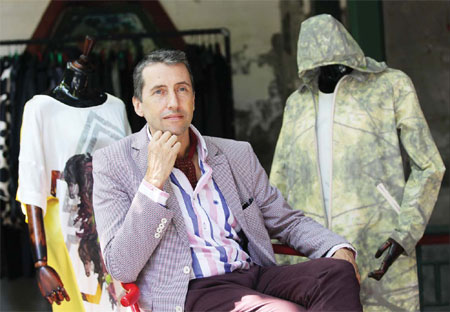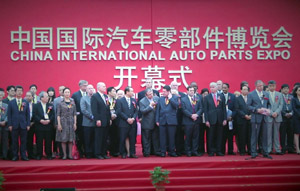Out with monovision, in with multi-branding
Updated: 2013-09-20 15:36
By Joseph Catanzaro (China Daily)
|
|||||||||||
A British fashion consultant reckons he has found the solution to a problem that has hampered the industry in China
Peter Caplowe weaved his way through the crowds thronging Nanluoguxiang in Beijing, neatly stepping around stylish young couples browsing the ancient alleyway turned shopping hotspot.
The British-born executive and consultant, who has made a name for himself in the notoriously fickle international designer clothing business over 20 years, is certain of at least one thing: In the world in which he moves, the flood of image-savvy Chinese youths flowing past him is a river of gold.
Sitting in the shaded courtyard of a hutong residence that was once the childhood home of a Qing Dynasty (1644-1911) empress, Caplowe talks of an immutable truth in international designer clothing: Styles change, trends end, and fads are just that, but making money is never out of fashion.
And the money, he says, is now in China.
For many European and US fashion labels though, finding a way to break into the Chinese market so they can access that wealth is challenging for several reasons.
Caplowe, 50, thinks a new venture he has co-founded with business partner Richard Hobbs will make the process much easier.
Caplowe's brainchild, called the Hub, is an exclusive, international branded fashion trade show that was launched last month in Hong Kong.
"The Hub is for the international market to meet Asian retailers," Caplowe says. "But when we spoke to all the brands about what excited them the most about the Hub, universally they said China."
The caliber of international brands that decided to take part in the new venture speaks volumes about the industry's interest in China.
The Economist Intelligence Unit has suggested that China, the world's biggest clothing manufacturer, is now at the center of what will soon be the fashion world's biggest retail market.
In a report published by PricewaterhouseCoopers at the end of 2011, the EIU said the value of the Chinese mainland clothing and apparel market was worth more than $47 billion (35 billion euros) annually, a figure that eclipses even the once seemingly unassailable market in Hong Kong.
According to the National Bureau of Statistics of China, the 2011 coup for the mainland market came after it enjoyed 24.2 percent growth in sales on the previous year. Driven by demand from China's rapidly expanding middle class, the EIU said the annual value of the mainland clothing and apparel market is expected to be more than $90 billion by 2015.
That same year, the EUI predicted, the value of the clothing and apparel market in Asia would rise to $263 billion annually, surpassing the European market's estimated worth of $172 billion and the US market's estimated worth of $192 billion.
Tokyo blew its chance to be the fashion hub of Asia because it remained insular and refused to "adapt to the global system", Caplowe says.
The Milan of the East has yet to be crowned, and all eyes are now on China.
"There isn't a center for fashion in Asia," Caplowe says.
"Chinese business culture is dynamic and fast moving. I think it's likely that the center of branded fashion will be in greater China."
Caplowe made his mark in the 1990s when he turned a small, boutique Japanese jeans brand, Evisu, into a near global success story worth about $100 million at its peak.
After cutting ties with the company in 2007, Caplowe, now based in Hong Kong, turned to consultancy.
"During that time when I was talking to a lot of Chinese companies, it was clear to me that a lot of them were interested in tying up with international brands, but they didn't know how to do it. There isn't a number to call or a place to go. Some Chinese companies approached me and said, 'Can you find us brands externally?'"
"It sort of just became clear to me that there would be a trade show in Asia where international brands come to meet Chinese retailers. I thought it might as well be me who did it."
Caplowe said "most of the large" Chinese retail operators attended the inaugural Hub event last month, which featured stalls from about 100 international branded fashion and apparel companies, including the respected British heritage brands Barbour and Henri Lloyd and almost all of the top names in US street fashion.
"It is not the case that most big American and European brands are here in China already," Caplowe says.
"Style wise, the luxury brands got into China first. A lot of people in China think of Western fashion as being Gucci and Chanel. But if you live in the West, you don't see many people walking around in Gucci and Chanel."
He also says the strong showing was a testament to a key difference in the Chinese retail market that is hindering international brands from breaking in, and frustrating local designers from reaching the point where they can break out into the global market.
"There aren't that many multi-brand stores in China," he says.
Instead, Caplowe says, the Chinese retail market is dominated by the mono-brand franchising model, which means international brands wanting to break in must have enough finance and backing to open multiple stores across the country that exclusively stock their product.
And the franchising mode is struggling in China, he says.
Escalating overheads including soaring rents and higher wages are eating into the 40 per cent profit margin most franchisees operate on. If the product they stock goes out of fashion, and sales fall, there is no recourse to bringing in another more popular brand.
Conversely, Chinese fashion designers who are just starting out have no real avenue for the type of gradual career development that could help them secure interest from the nation's retail juggernauts.
The solution to both problems, is more multi-brand stores, Caplowe says.
This type of retailing will naturally evolve in China, he says, but he is now in talks with Beijing-based operators Chic about starting an association that would act as a representative body to hasten the process.
Artfully placed articles of apparel and clothing are scattered around the courtyard in the hutong where Caplowe sits and talks.
Once the childhood home of Wan Rong, the wife of the last Qing emperor Puyi, it is now a place of business for Wuhao, a multi-brand fashion and apparel shop.
But while boutique multi-brand stores do already exist in China, they are a minority. To allow local talent to achieve its full potential, this will have to change, he says.
As the country gradually moves away from manufacturing and toward a consumer-driven economy, fostering local design talent makes sense, Caplowe says.
"The bigger the domestic branded fashion market is, the better that is for the manufacturers here in China."
The long-term plan is to bring Chinese branded fashion to the rest of the world, too, he says.
In Wan Rong's courtyard, where past and present collide, Caplowe says any way you look at it China will play a major role in the future of international fashion.
The challenge for those yet to break into the market is not striking a pose; it's striking a deal.
josephcatanzaro@chinadaily.com.cn
|
Though it is difficult to break into the Chinese market, Peter Caplowe has made it much easier by starting a fashion trade show in Hong Kong. Zou Hong / China Daily |
(China Daily European Weekly 09/20/2013 page22)
Today's Top News
Verdict of Bo Xilai: Life in prison
Russian embassy to Syria shelled
Gunmen holding hostages in Nairobi
Amber alert across Asia, but not red
China signs 12 deals with Venezuela
Bo Xilai gets life in prison
New Sino-US ties sought
One Chinese killed in Nairobi attack
Hot Topics
Lunar probe , China growth forecasts, Emission rules get tougher, China seen through 'colored lens', International board,
Editor's Picks

|

|

|

|

|

|






